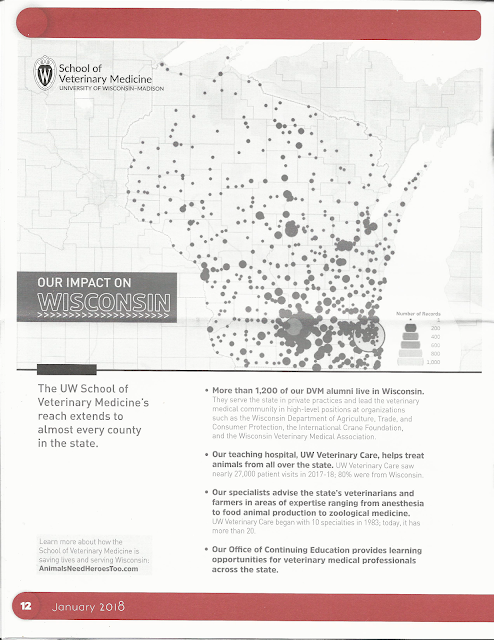Historical Data
of the WVMA Membership Over the Years
Compiled by Fred J. Born, DVM
In 1959, WVMA membership was between 700-800 active
veterinarians.
In 1988, the WVMA membership was between 1000 -
1100
Then 20 years later, in 2008 the WVMA membership
had reached 2,200. At the end of 2008,
the membership breakdown was as follows:
Active membership (veterinarians): 2,160
Students members: 163
Students were allowed to join the WVMA (dues
$10) in the summer of 2001.
(The By-laws vote to accept them officially was
made at the WVMA Convention in October
of 2001. Changes to the By-laws were
allowed to be acted on prior by a vote of the members. If the motion had been defeated, the student membership
status would have reverted back to non-members.)
“During the years from 2001 and 2008, the WVMA,
as an association, things happen and happen because of the people who work for
it – membership recruitment and retention, state laws, projects, conventions,
etc. The lifeblood of any successful
association is the administration staff.
Over the years, the WVMA organization had the
largest percentage of eligible members than any other state. We used to have waiting lists of people who
wanted to serve on committees”.
Reference:
Personal communication from Leslie Grendahl
In June 2008, when Kim Brown-Pokorny took over as
the WVMA Executive Director, the WVMA Membership was 2160
plus 163 student memberships.
2009 WVMA Membership Directory
These directories held a wealth of information,
such as:
The listing of WVMA Past-presidents
The listing of the WVMA Award Recipients
Members of the Wisconsin Board of Veterinary
Examiners
Articles of Incorporation/Bylaws
Wisconsin State Senators and Representatives
Shown below is the second last WVMA Directory to
be printed in 2009:
But, from the year of 2009 with a WVMA membership of 2160 to the year of 2014, when the
WVMA membership decreased 434 members.
As the 2014 membership fell to 1726.
The beginning of 2015, according to the WVMA web
site, membership was over 2300 (an increase of less than 200 in 6 years)
With the 100th Anniversary, at the end of 2015,
an increase of 366
End of 2016, an increase of 238
End of 2017, an increase of 182
Was amazed to see the ad below by the UW-Madison
SVM in the Jan. 2018 - WVMA Newsletter stating over 1200 Alumni live in
Wisconsin.
The UW-Madison SVM first class graduated in
1987. There have been 32 SVM Classes
since ’87. If they have an average of 75
grads per year (data given by the UW-Madison SVM). Doing the math, we have had a total of 2400
UW-Madison SVM grads. If only half of
the total grads (1200 Alumni) are living in Wisconsin, why aren't the WVMA
membership numbers increasing?
With the previous data of 1988, the WVMA
membership was between 1000 – 1100.
Assuming our UW-Madison SVM grads (1200) were joining
over these years to the present, our membership should be between 2400 to 2500,
plus the current active membership numbers. This doesn’t make any sense.
The following data is from the WVMA office,
covering the last six years:
2014- 1726
2015- 2092 - increase of 366
2016- 2230 – increase
of 148
2017- 2412 – increase of 182
2018- 2486 – increase of 74
2019- 2381 – decrease of 105
At the end of 2018, an increase of only 74
In summary: In 2008 we had an active WVMA
Membership of 2160, then by 2018,
over a ten year span we had an increase of 326
members. That is an average of 33 new
members each year. This was a concern
for the WVMA leadership.
Our WVMA Executive
Director, Kim Brown-Pokorny directed the WVMA Executive Board to change the By-laws to allow a
change in WVMA Membership and allow Clinical Staff Team members to join.
In November 2018, this announcement was sent to
all WVMA members:
WVMA Membership Now Open to Clinic Staff!
|
The opportunity to join the WVMA is now
available to all clinic staff team members!
This new member category was approved by the
WVMA membership earlier this year.
WVMA membership would allow clinic staff team
members to have representation
on state policy issues, access the monthly online WVMA Voice newsletter,
receive updates of upcoming CE events, have member web access which
includes 1000+ RACE-approved CE opportunities, and receive the member
rate at all WVMA events.
Act NOW and SAVE!
The annual membership rate for clinic staff
team members is $45 per person. Staff who are part of a clinic where the
veterinarians have paid their 2019 WVMA dues can join for just $20 per
person, if they do so before February 15, 2019.
Now the new WVMA Membership dues schedule is:
Veterinian
$255 per year
Out-of-state Veterinian $135 per year
Veterinary Medical Student $20 per year
Non-Veterinian $135 per year
Clinical Staff Team member $45 per year
Veterinary Medical Industry $275 per year
Military, UW-SVM, Regulatory or Public Health $185
per year
The results would be
predicable:
At the end
of 2019, a decrease of 105 members with a grand total of 2381.
The change in
membership status did not help.
The above record is
well documented.
|
In 2008: The WVMA had 2160 members and by at the
end of 2019, eleven years later the WVMA had a membership of 2381.
In 12 years, the WVMA gained 221 members under
the leadership of the former WVMA Executive Director, Kim Brown-Pokorny.
Additional interesting information:
Had written to the Wisconsin Veterinary Examining Board at the end of
May 2019,
below is the reply from the WVEB spokesperson.
June
1, 2019
If
we have 3841 veterinarians, including Faculty, Post Graduate Training
Permits and
Temporary
Consulting Permits. That figures about
1,500 veterinarians are not WVMA members.
Sally
A.S. Ballweg
License/Permit
Program Associate
Veterinary
Examining Board
Wisconsin
Department of Agriculture, Trade and Consumer Protection
(608)
224-4353 / DATCPVEB@wisconsin.gov











